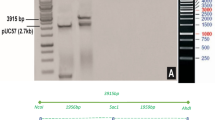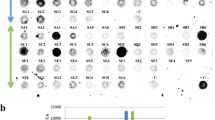Abstract
We have analysed two herbicide resistant transgenic tobacco (Nicotiana tabacum) and four potato (Solanum tuberosum) lines under field conditions. These lines resulted from Agrobacterium mediated transformation of tobacco and potato leaf discs with chimeric bar genes encoding phosphinothricin acetyl transferase (PAT). Greenhouse tests have demonstrated that this enzyme protects transformed plants against the broad–spectrum herbicides glufosinate and bialaphos. In field tests, the transformants revealed the same agronomic performance as untransformed controls. Complete resistance to field dose applications of glufosinate was observed, although PAT expression in these lines varied by two orders of magnitude. These field data confirm that glufosinate can be applied as a selective post–emergence herbicide on engineered crops.
This is a preview of subscription content, access via your institution
Access options
Subscribe to this journal
Receive 12 print issues and online access
$209.00 per year
only $17.42 per issue
Buy this article
- Purchase on Springer Link
- Instant access to full article PDF
Prices may be subject to local taxes which are calculated during checkout
Similar content being viewed by others
References
Comai, L. and Stalker, D. 1986. Mechanism of action of herbicides and their molecular manipulation. Oxford Surveys of Plant Molecular and Cell Biology 3:167–195.
Botterman, J. and Leemans, J. 1988. Engineering of herbicide resistance. Trends in Genetics 4:219–222.
De Block, M., Botterman, J., Vandewiele, M., Dockx, J., Thoen, C., Gosselé, V., Movva, N., Thompson, C., Van Montagu, M., and Leemans, J. 1987. Engineering herbicide resistance in plants by expression of a detoxifying enzyme. EMBO J. 6:2513–2518.
Kondo, Y., Shomura, T., Ogawa, Y., Tsuruoka, T., Watanabe, H., Totukawa, K., Suzuki, T., Moriyama, C., Yoshida, J., Inouye, S., and Niida, T. 1973. Studies on a new antibiotic SF-1293 1. Isolation and physico-chemical and biological characterization of SF-1293 substances. Sci.Rep.Meiji.Seika 13:34–41.
Tashibana, K., Watanabe, T., Sekizuwa, Y. and Takematsu, T. 1986. Accumulation of ammonia in plants treated with bialaphos. Journal of PesticideScience 11:33–37.
Bayer, E., Gugel, K.H., Haegele, K., Hagenmaier, H., Jessipow, S., Koenig, W.O., and Zaehner, Z. 1972. Stoffwechselprodukte von Microorganismen 98. Mitteilung:Phosphinothricin und Phosphmothricyl-Alanyl-Alanin. Helvetia Chimica Acta 55:224–239.
Murakami, T., Anzai, H., Imai, S., Satoh, A., Nagaoka, K., and Thompson, C.J. 1986. The bialaphos biosynthetic genes of Streptomyces hygroscopicus: molecular cloning and characterization of the gene cluster. Mol and Gen.Genet 205:42–50.
Thompson, C., Movva, N., Tizard, R., Cramen, R., Davies, J., Lauwereys, M. and Botterman, J. 1987. Characterization of the herbicide resistance gene bar from Streptomyces hygroscopicus . EMBO J. 6:2519–2523.
Nelson, R.S., McCormick, S.H., Delannay, X., Dubé, P., Leyton, J., Anderson, E.J., Koniewska, M., Proksch, R.K., Horsch, R.B., Rogers, S.G., Fraley, R.T., and Beachy, R.N. 1988. Virus tolerance, plant growth and field performance of transgenic tomato plants expressing coat protein from tobacco mosaic virus. Bio/Technology. 6:403–409.
Snedecor, G.W. and Cohran, W.G. 1980. Statistical Methods, Iowa State University Press.
Velten, J., Velten, L., Ham, R. and Schell, J. 1984. Isolation of a dual promoter fragment from the Ti-plasmid of Agrobacterium tumefaciens . EMBO J. 3:2723–2730.
Deblaere, R., Reynaerts, A., Höfte, H., Hernalsteens, J.-P., Leemans, J., and Van Montagu, M. 1987. Vectors for cloning in plant cells. Meth.in Enzymol. 153:277–292.
Comai, L., Faccioti, D., Hiatt, W.R., Thompson, G., Rose, R.E., and Stalker, D.M. 1985. Expression in plants of a mutant aroA gene from Salmonella typhimurium confers tolerance to glyphosate. Nature 317:741–744.
Shah, D.M., Horsch, R.B., Klee, H.J., Kishore, G.M., Winter, J.A., Turner, N.E., Hironaka, C.M., Sanders, P.R., Gasser, C.S., Aykent, S., Siegel, N.R., Rogers, S.G., and Fraley, R.T. 1988. Engineering herbicide tolerance in transgenic plants. Science 233:478–481.
Falco, S.C., Knowlton, S., LaRossa, R.A., Smith, J.K., and Mazur, B.J. 1987. Herbicides that inhibit ammo acid biosynthesis the sulfonylureas—a case study p. 149–158 In: 1987 British Crop Protection Conference Weeds, BCPC Publications Surrey UK.
Shaner, D.L. and Andersson, P.C. 1985. Mechanism of action of the imidazolmones and cell culture selection of tolerant maize, p. 287–299 In: Biotechnology in Plant Sciences. Zaitlin, M., Day, P.and Hollaender, A.(Eds.).Academic Press, Inc NY.
De Block, M. 1988. Genotype independent leaf-disc transformation of potato (Solanum tuberosum) using Agrobacterium tumefaciens . Theor. Appl. Genet. In press.
Stalker, D.M., McBurke, K.E. and Malyj, L.D. 1988. Herbicide resistance in transgenic plants expressing a bacterial detoxification gene. Science 242:419–423.
Author information
Authors and Affiliations
Rights and permissions
About this article
Cite this article
Greef, W., Delon, R., Block, M. et al. Evaluation of Herbicide Resistance in Transgenic Crops Under Field Conditions. Nat Biotechnol 7, 61–64 (1989). https://doi.org/10.1038/nbt0189-61
Received:
Accepted:
Issue Date:
DOI: https://doi.org/10.1038/nbt0189-61



